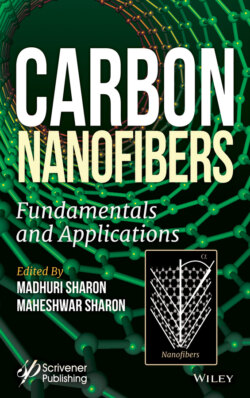Читать книгу Carbon Nanofibers - Группа авторов - Страница 87
3.6.5 Electrospinning Method
ОглавлениеElectrospinning is a process that uses an electric potential to overcome the surface tension of a solution to produce an ultrafine jet, which elongates, thins and solidifies as it travels through the electric field to a collector (Figure 3.8). Despite being a relatively simple procedure to undertake in a laboratory, as it requires minimal equipment, the physics behind the process are complex. To gain an understanding of all the variables and interactions involved in electrospinning, consideration must be given to polymer chemistry, electric field interactions, fluid mechanics, environmental conditions and kinetics. CNFs are prepared from acrylonitrile, pitch, polyimide, poly(vinylidene fluoride) and phenol via electrospinning followed by carbonization. The properties of the final CNFs are decided by the types of polymer solution and the processing parameters. Once the polymer nanofibers have been successfully prepared, a heat treatment is applied to carbonize the polymer nanofibers to form CNFs. The morphology, purity, crystallinity, diameters and porosity are governed by the parameters of the heat treatment process such as atmosphere and temperature. The carbonization process is followed by heating the polymer nanofiber up to 1000 °C in a specific environment. Generally, volume and weight change occur during the carbonization process, which results in the decrease of the diameter of the CNFs. In most cases, the CNFs prepared by the electrospinning method are prone to form web or mat structures, which are used as electrode materials for batteries, supercapacitors, electrochemical capacitors, anode for lithium-ion rechargeable batteries, catalyst support and composite.
Figure 3.8 Schematic diagram of the electrospinning setup used for CNF fabrication. (Source: Feng et al. 2014) [57].
There are two major approaches of CNF production based on the precursor’s state of matter: solid-phase synthesis and vapor-phase synthesis. The precursor materials used for CNF production by electrospinning are in their solid state at the initial stage of fabrication. Precursors are aligned in fibers through different spinning techniques, followed by stabilization and carbonization at temperatures up to about 1300 °C. Recently, exploitation of a gaseous state of precursors has also gained in popularity. Vapor-grown carbon fibers (VGCF) are prepared by thermal decomposition or chemical vapor decomposition (CVD) of organic precursors, where stabilization is not necessary. While fibers’ solid-phase precursors are obtained as a continuous fiber with different morphologies (monofibers, strands of fibers, woven fabric with diverse woven modes, chopped fibers and also nonwoven mats), the vapor-grown carbon fibers are relatively short [52]. Some of the common solid phase CNF precursors given below.
